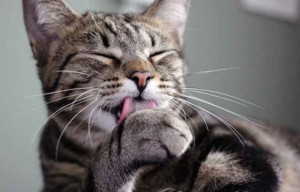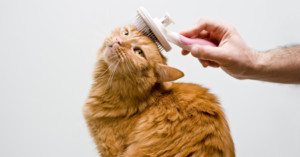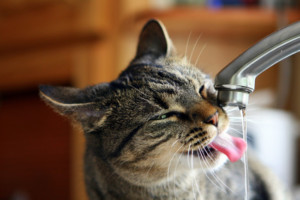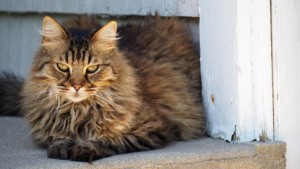If you have a longhaired cat, you could probably write the book on hairballs! However, what a lot of cat owners don’t know is that while hairballs are a natural part of cat-life, it’s actually not normal for them to be frequently hacking up hairballs!
Cat hair is actually pretty difficult on a kitty’s digestive system. It can’t really pass through their intestinal tract, and their stomach enzymes aren’t quite equipped to digest it. If a cat is an average groomer, with short to medium hair, usually the hair they ingest can simply be passed in a stool. However, unfortunately this is often not the case, and the cat has no choice but to yak up a hairball! Hairballs can even get to the point where they are blocking the intestinal tract, making it impossible for the mass to get out one way or another. This can lead to a really dangerous impaction, often resulting in surgery to relieve it.
If you know your kitty is a constant hairball yakker, keep an eye out for these signs of a possible impaction:
Vomiting of undigested food
Dry retching
Inability to defecate
Diarrhea
Swollen or distended abdomen
**If you notice any of these symptoms, it’s important to visit your vet right away!
Luckily, we don’t have to just sit around and watch our kitties suffer through hairballs. There are a lot of preventative and management options if you have a cat who is particularly prone to hairballs.
Grooming: Many cat owners think “oh my cat grooms himself, he doesn’t need me!”. While your kitty may be an expert groomer, most cats appreciate a little bit of help. There are a million and one brushes out there, so be sure to choose one that is the most comfortable for your cat, and for you. For example, if you have a short-haired kitty, a brush with wire bristles likely would not be an appropriate choice. So try looking for one with shorter, nubbier, rubber bristles! There are also specialized grooming tools created specifically to help a cat shed. For example, the “Furminator” is excellent at lifting excess hair off a cat’s body, so they don’t have to do that themselves. Moral of the story: brushing your cat is the fastest and easiest way to reduce hair ingestion and also keep hair off your furniture (a major plus). But, if your cat is not a fan of the brush, check out these other options…
Fiber: Oral hairball remedies are available to make it easier for your kitty to pass hairballs into their litter box. Cat Grass is actually a super simple source of fiber that is easy to keep in your home and loved by most cats. Cat grass grows very quickly, is easy to care for, and is completely chemical free. Just be wary if you have a kitty who loves the cat grass a bit too much! Sometimes cats do overindulge and make themselves sick, so you may have to give them just a little bit at a time, rather than leaving a whole pot of it at their disposal.
Laxatives: There is a wide variety of petroleum based laxatives and hairball remedies at your disposal, flavored to make them palatable for your kitty. These work to coat the ingested hair, making it easier to pass through the cat’s system. Definitely ask your vet for suggestions as to which would be the best option for your cat, and how to administer.
WATER: If you tuned in on our previous post about How To Feed Your Cat, you know that cats are not generally inclined to drink a lot of water. However, it is vital that fresh, clean water is constantly available for your cat’s digestion. Therefore, if they prefer running water, bend to their whims and invest in a water fountain. If they like drinking out of cups, you got it, place a few around the house for their drinking needs. But most importantly, add wet food to your cat’s diet. Because cats are designed to get most of their water from their food, most domesticated cats miss out on water intake if they don’t have wet food as a part of their daily diet. Canned cat food is generally about 78% water, so it’s a great idea to add that into your cat’s diet if they aren’t big water drinkers.
At the end of the day, if you employ these measures and your cat is still struggling with hairballs, speak to your vet! Again, while hairballs are a natural part of being a cat, they certainly should not be a very frequent occurrence, and definitely should not be negatively impacting on a cat’s quality of life!







